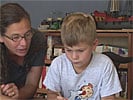How the Well-Baby Program Supports Healthy Child Development

Check out our blog for social-emotional learning articles, news, and more!

Brotman, L.M., Dawson-McClure, S., Huang, K., Theise, R., Kamboukos, D., Wang, J., Petkova, E., and Ogedegbe, G. (2012). Early Childhood Family Intervention and Long-term Obesity Prevention Among High-risk Minority Youth. Pediatrics 129(3). DOI: 10.1542/peds.2011-1568.
Abstract
OBJECTIVES: To test the hypothesis that family intervention to promote effective parenting in early childhood affects obesity in preadolescence.
METHODS: Participants were 186 minority youth at risk for behavior problems who enrolled in long-term follow-up studies after random assignment to family intervention or control condition at age 4. Follow-up Study 1 included 40 girls at familial risk for behavior problems; Follow-up Study 2 included 146 boys and girls at risk for behavior problems based on teacher ratings. Family intervention aimed to promote effective parenting and prevent behavior problems during early childhood; it did not focus on physical health. BMI and health behaviors were measured an average of 5 years after intervention in Study 1 and 3 years after intervention in Study 2.
RESULTS: Youth randomized to intervention had significantly lower BMI at follow-up relative to controls (Study 1 P = .05; Study 2 P = .006). Clinical impact is evidenced by lower rates of obesity (BMI $95th percentile) among intervention girls and boys relative to controls (Study 2: 24% vs 54%, P = .002). There were significant intervention-control group differences on physical and sedentary activity, blood pressure, and diet.
CONCLUSIONS: Two long-term follow-up studies of randomized trials show that relative to controls, youth at risk for behavior problems who received family intervention at age 4 had lower BMI and improved health behaviors as they approached adolescence. Efforts to promote effective parenting and prevent behavior problems early in life may contribute to the reduction of obesity and health disparities. Pediatrics 2012;129:1–8





